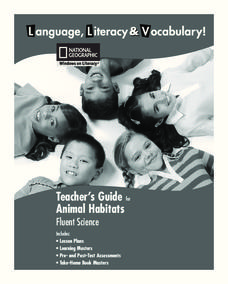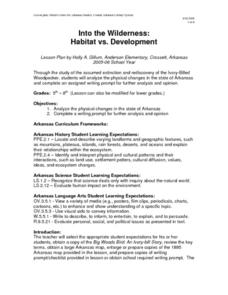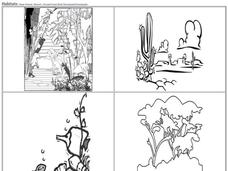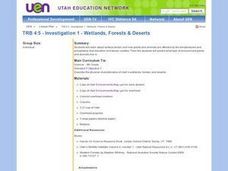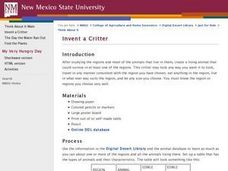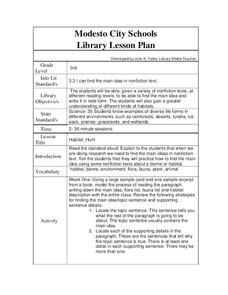National Geographic
Animal Habitats
Explore animal habitats and reinforce speaking, listening, reading comprehension, and writing skills with a unit that focuses on the Arctic, desert, ocean, prairie, and rainforest. Enthusiastic scientists read informational text to...
Core Knowledge Foundation
Animals and Habitats Tell It Again!™ Read-Aloud Anthology
A read-aloud anthology explores various habitats and the animals that inhabit them, from the Artic to the desert, the forest, and bodies of water. First graders listen to and discuss texts and complete word work. Each lesson offers...
Curated OER
Into the Wilderness: Habitat vs. Development
By studying the once-assumed extinction, then rediscovery of the Ivory-Billed Woodpecker, learners look at the physical changes that have occured in habitats throughout Arkansas. This outstanding lesson is chock full of terrific...
Curated OER
Deserts: How Do You Define One?
Second graders identify what constitutes as a desert by reading a habitat checklist. In this environment lesson, 2nd graders read a nature website to discover facts about the desert and where they are located. Students...
Curated OER
Habitats Activity
In this habitat worksheet, learners identify and sort the animals in a box of animal crackers to the habitats to which they belong and then create a graph to document how many animals fit into each habitat.
Curated OER
Whose Home Is This?
After reading a short and informative paragraph on animals and their environments, learners look at pictures of four animals, and write a short description of how each one has adapted to its environment. A suggested activity is that each...
Curated OER
Habitats
In this habitats activity, learners view and discuss four slides with four different habitats found in the rain forest, desert, ocean/coral reef and in the Savannah/grasslands. Students color each slide with vibrant colors.
Curated OER
Close to Home
Fourth graders examine habitats for animals by creating their own in class environment. For this environment lesson, 4th graders research the Internet for information on certain wild animals and the places in which they live....
Curated OER
Food Chains
In this food chain worksheet, students draw in a food web for 6 different habitats: woodland, garden, pond, sea, arctic, and desert. This worksheet is a graphic organizer.
Curated OER
Jumanji
Third graders read the book, Jumangi. Then they divide into groups of four or five and choose a habitat - desert, wetlands, Arctic/Antarctic, etc. Then each group can research the habitat to learn what kind of animals live there.
Curated OER
Habitats Black and White Pictures: Farm, Forest, Wetlands, Polar
In this science worksheet, students examine black and white drawings of 4 habitats: farm, forest, wetlands and polar. There are no questions on the page.
Curated OER
Investigation 1 - Wetlands, Forests & Deserts
Fourth graders examine surface terrain and how plants and animals are affected by the temperatures and precipitation that elevation and terrain creates. Then students predict what type of environment plants and animals live in.
Curated OER
Habitats Pictures: Farm, Forest, Wetlands, Polar
In this science worksheet, students examine color pictures of 4 different habitats: farm, forest, wetlands and polar. There are no questions to answer.
Curated OER
Survival of the Spiniest
For this earth science worksheet, students identify and discover the amazing ways that desert plants adapt to harsh habitats. They use discussion and drawing to explore their existing knowledge about deserts. Then, students respond to 15...
Curated OER
Invent a Critter
Students create a living animal that could survive in at least one specific region and use the digital desert library to gather information. In this invent a critter lesson, students draw a picture of their animal, describe their...
Desert Discovery
Leaping Lizards
Here is a fine biology lesson that introduces youngsters to reptiles. They study their feeding habits, their habitats, and the adaptations they must make to survive in their environments. The outstanding lesson includes two excellent...
Curated OER
Camouflage
First graders learn how plants and animals adapt to their environments. In this camouflage lesson plan, 1st graders watch a movie that explains animal camouflage, design a butterfly that blends into a classroom habitat, create a...
Curated OER
Animal Colors and Shapes
Students investigate the natural characteristics of animals by completing a coloring activity. In this animal properties activity, students investigate the reasons different animals have specific colors, and how it is essential for...
Curated OER
Playing Hot and Cold
Students read about homeothermy. Through research and poster projects, they gain insight into the diversity among mammals and the ways specific mammals survive in their native climates.
Curated OER
Who Lives Here?
Students explore the concept of philanthropy. In this environmental stewardship instructional activity, students examine water conservation efforts in desert regions as they act as members of a city council committee investigating the...
Curated OER
Habitat Hunt
Third graders read several nonfiction texts and practice finding the main idea for the text as well as learn about various habitats. In this main idea lesson, 3rd graders read several nonfiction texts and make habitat cards. Students...
Curated OER
Your Favorite Wild Animal
In this research skills activity, students select a wild animal and then respond to 5 short answer questions regarding it. In addition, students draw a picture of it and define 6 habitat terms.
Curated OER
No Place Like Home?
Students investigate the impact of the physical environment on an endangered species. They create a plan for the ideal care of the species and develop an advertisement to promote awareness about the need for its protection.
Curated OER
The Great Horned Owl
For this recognizing facts about the Great Horned Owl worksheet, students read fun facts, match illustrations with adaptations, sequence life cycle cards, and read what to do if they find an injured bird. Students solve 16 answers.
